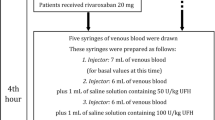Abstract
Enoximone is a selective inhibitor of the phosphodiesterase-III enzyme (PDE-III) and possesses positive inotropic and vasodilatory properties. The PDE-inhibitor amrinone has been associated with adverse effects on coagulation by decreasing platelets. To investigate the influence of enoximone on hemostasis, 18 patients undergoing elective aorto-coronary bypass grafting and receiving enoximone were compared to a control group (n=18). In addition, the plasma levels of enoximone and its major metabolite (enoximonesulfoxide) were studied following a single injection (0.5 mg/kg) and during a continuous infusion (5 and 10 μg/kg·min) before, during and after extracorporeal circulation (ECC). No difference between study and control groups was found for the parameters of coagulation during the investigation period; in particular there were no differences in platelet count and platelet function (thrombelastography). Following the single bolus, peak plasma levels decreased during ECC to ineffective levels. Continuous infusion, however, maintained effective plasma levels of enoximone; sulfoxide levels were twice as high as enoximone concentrations up until the end of the investigation period. It is concluded that enoximone can be judged to be safe in respect to its effects on coagulation even following ECC and at relatively high doses. The use of continuous infusion results in plasma levels which remain at an effective concentration through to the time that the patient is transferred to the intensive care unit.
Similar content being viewed by others
Change history
12 June 2023
This article has been retracted. Please see the Retraction Notice for more detail: https://doi.org/10.1007/s00134-023-07122-8
References
Alden RG, Belz CG, Haegele (1984) Kinetics of enoximone, a new cardiotonic drug, in healthy subjects. Clin Pharmacol Ther 36:209
Ansell J, Tiaks C, Mc Cue J, Parilla N, Benotti JR (1984) Amrinone-induced thrombocytopenia. Arch Intern Med 144:949
Appleman MM, Beavo JA, Hardman HG, Klee CB, Thompson WJ (1984) A subcommittee for nomenclature recommendations. Adv Cyclic Nucleotide Protein Phosphorylation Res 16:vi
Bick RL, Schmalhorst WR, Argegast NR (1976) Alterations of hemostasis associated with cardiopulmonary bypass. Thromb Res 8:285
Boldt J, Kling D, Scheld HH, Hempelmann G (1988) Efficacy of the new phosphodiesterase-inhibitor enoximone in comparison to dobutamine in coronary surgery patients. Herz 13:335
Boldt J, Kling D, Marck P, Hempelmann G (1989) Hemodynamic effects of the new phosphodiesterase inhibitor enoximone. Anaesthesist 38:238
Braunwald E (1986) Newer positive inotropic agents. Introduction. Circulation 73 [Suppl III]:III1
Chan KY, Ohlweiler DF, Lang JF, Okerholm RA (1984) Simultaneous analysis of a new cardiotonic agent, MDL 17,043 and its major sulfoxide metabolite in plasma by high-performance liquid chromotagraphy. J Chromatogr 306:249
Chatterjee K, Kereiakes D, Viquerat C, Podolin R (1987) Potential mechanism of improved left ventricular function with enoximone in severe congestive heart failure. Am J Cardiol 60:37C
Colucci WS, Wright RF, Braunwald E (1986) New positive inotropic agents in the treatment of congestive heart failure. Second Part. N Engl J Med 314:349
Dage RC, Roebel LE, Hsieh CP, Weiner DL, Woodward JK (1982) Cardiovascular properties of a new cardiotonic agent: MDL 17,043. J Cardiovasc Pharmacol 4:500
Dage RC, Kariya T, Hsieh CP, Roebel LR, Cheng HC, Schnettler RA, Grisar JM (1987) Pharmacology of enoximone. Am J Cardiol 60:10C
DiBianco R, Shabetai R, Silverman BD, Leier CV, Benotti JR, Silverman E, Steele P, Merill A, Weinstein NA, Brehm J, Gerber L, Singh SN (1984) Oral amrinone for treatment of congestive heart failure. Results of a multicenter randomized double blind and placebo controlled withdrawal study. Am Coll Cardiol 4:855
Endoh M, Yanagisawa T, Morota T, Taira N (1985) Differential effects of sulmazole on contractile force and cyclic AMP levels in canine ventricular muscle in comparison with MDL 17,043. J Pharmacol Exp Ther 234:267
Erbel R, Meyer J, Diefenbach C, Delorme G, Bourdarias JP, Vernant P, Lellouche D, Mattioli G, Barbieri A, Installe E, Gonzalez M, Mitrovic V, Neuzner J, Salvade G (1987) A dose-response study of enoximone in congestive heart failure. Am J Cardiol 59:31C
Günnicker M, Hess W (1987) Preliminary results with amrinone in perioperative low cardiac output syndrome. Thorac Cardiovasc Surg 35:219
Hennessy VL, Hicks RE, Niewiaroski S, Edmunds LH, Colman RW (1977) Function of human platelets during extracorporeal circulation. Am J Physiol 232:H622
Kariya T, Wille LJ, Dage RC (1982) Biochemical studies of the mechanism of cardiotonic activity of MDL 17,043. J Cardiovasc Pharmacol 4:509
Madhoc R, Taylor K, Brannan J, Bradley H, Forbes CD (1984) Inhibition of platelet aggregation during cardiopulmonary bypass in dogs. In: Hagl S, Klövekorn WP, Mayr N, Sebening F (eds) Thirty years of extracorporeal circulation. Deutsches Herzzentrum München, p 363
Mancini DM, Keren G, Aogaichi K, LeJemtel TH, Sonnenblick EH (1985) Inotropic drugs for the treatment of heart failure. J Clin Pharmacol 25:540
Okerholm RA, Chan KY, Lang JF, Thompson GA, Rudberg SJ (1987) Biotransformation and pharmacokinetic overview of enoximone and its sulfoxide metabolite. Am J Cardiol 60:21C
Scholz H (1984) Inotropic drugs and their mechanism of action. JACC 4:389
Treadway G (1985) Clinical safety of intravenous amrione — a review. Am J Cardiol 56:39B
Uretsky BF, Generalovich T, Reddy PS (1984) Acute hemodynamic effects of oral MDL 17,043 in severe congestive heart failure. Am J Cardiol 54:357
Weber KT, Janicki JS, Jain MC (1986) Enoximone (MDL 17,043), a phosphodiesterase inhibitor, in the treatment of advanced, ustable chronic heart failure. J Heart Transplant 5:105
Weishaar RR, Burrows DC, Koylarz DC, Quade MM, Evans DV (1986) Multiple molecular forms of cyclic nucleotide phosphodiesterases in cardiac and smooth muscle and in platelets. Biochem Pharmacol 35:787
Author information
Authors and Affiliations
About this article
Cite this article
Boldt, J., Kling, D., Dieterich, H.A. et al. RETRACTED ARTICLE: The new phosphodiesterase inhibitor enoximone in patients following cardiac surgery — pharmacokinetics and influence on parameters of coagulation. Intensive Care Med 16, 54–59 (1990). https://doi.org/10.1007/BF01706326
Received:
Accepted:
Published:
Issue Date:
DOI: https://doi.org/10.1007/BF01706326




